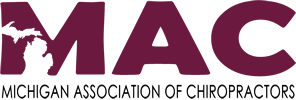Complete Story
01/03/2020
Second Phase of MAC-Priority Health Partnership Began January 1st!
E/M Codes to be “Carved Out” of Per Diem Payment
Last July, after months of negotiations, MAC Executive Director Kristine Dowell and our Legal Affairs Committee announced that the MAC and Priority Health are working together on a very special project. We believe that this partnership is a win-win for the MAC, the chiropractors in Priority’s network, and – most importantly – the chiropractic patients they serve.
In the first phase of this historic agreement, which became effective July 1, 2019, Priority Health increased commercial chiropractic per diem fees by an initial 2%.
In the second phase, which began January 1st, Priority Health is increasing payment for initial evaluation and management codes (99201-99205) for commercial members to a rate of $65.15. Priority is also increasing payment for established evaluation and management codes (99211-99215) for commercial members to a rate of $41.41.
All other medical, billing and coding policies and standards remain in effect.
The final phase of the agreement with Priority is the designing of a performance- and outcomes-based payment methodology for CMT and physical medicine codes, based in part on medication use and cost, rate of spine surgeries, and chiropractic utilization. The parameters of this methodology have been developed, and we continue to collaborate with some of the profession’s foremost experts on data collection and analysis to show that chiropractic is not just cost-effective but will also greatly improve patient outcomes by reducing the rate of patients using dangerous prescription painkillers and undergoing surgical interventions.
We look forward to this partnership reaping tremendous benefits in the future.
Related: Billing for CMT and E/M
When Is It Appropriate to Bill an E/M Code on the Same Day as CMT?
By: Stephanie Davidson, MAC Insurance Relations Manager
With the second phase of the MAC’s agreement with Priority Health now in effect this is an appropriate time to provide a refresher on the proper use of evaluation and management (E/M) services in conjunction with Chiropractic Manipulative Treatment (CMT). Failure to properly code E/M services could not only increase the risk of triggering an audit, but also decrease your bottom line, if a significant amount of money is left on the table
E/M codes can be used in conjunction with CMT code set (98940-98943) only when the service is “significant” and “separately identifiable” from the routine assessment services performed within the basic code itself. According to the official Common Procedural Terminology (CPT) statement from the AMA regarding chiropractic use of an E/M code:
The chiropractic manipulative treatment codes include a pre-manipulation patient assessment. Additional Evaluation and Management services… may be reported separately using modifier 25 if the patient’s condition requires a significant, separately identifiable E/M service above and beyond the usual preservice and postservice work associated with the procedure.” – CPT 2018
In an article from the June 7, 2019, edition of Chiropractic Economics entitled “The Art and Skill of Evaluation and Management Coding,” Kathy Mills Chang and Yvette Noel outline the components of Pre/Intra/Post service work of the CMT as follows:
- Pre-Service Work: Review of patient’s records and diagnostic tests, communication with other providers, and the actual preparations for care.
- Intra-Service Work: Discussion about the service with the patient, a pertinent evaluation and assessment of the patient, and the procedure performed
- Post-Service Work: An evaluation and discussion with the patient about the effect of the treatment, arrangement of additional services or referral to another provider, discussion of the case with other providers, review of literature about the patient’s condition, and documentation of the service.
So, When Is an E/M Code Appropriate?
So, under what circumstances is it appropriate to bill both a CMT code and an E/M code on the same date of service? Some examples include:
- A new patient visit (a new patient is defined as one who has not received professional services in your office within the last three years)
- An established patient with a new condition or new injury
- An established patient with an aggravation/exacerbation/re-injury
- A periodic re-evaluation to assess if a change in treatment is warranted
Please note: E/M services must be supported by appropriate documentation. For more information, see CMS’s Medicare Learning Network’s “Evaluation and Management Services.”
Use of Modifier 25
When the work of both CMT and a distinct E/M code are performed, use the 25 modifier in conjunction with the E/M code to indicate that it is separate and distinct from the chiropractic manipulation and that BOTH were performed on the same visit. Failure to include the 25 modifier will result in the E/M service being denied as a duplicate service.
If only an E/M service is billed, the 25 modifier is not needed.
Additional Resources
- KMC University Chiropractic E/M Audit Tool
- “Evaluation and management codes…why bother?” by Kathy Mills Chang.
Sources:
2020 ChiroCode Deskbook, Chapter 6.2, E/M Coding
ACA Coding Policy, “CMT and E&M Reimbursement Solutions,” © 2015 American Chiropractic Association
Kathy Mills Chang, MCS-P, CCPC, CCCA, and Yvette Noel, CPCO, “The Art and Skill of Evaluation and Management Coding,” Chiropractic Economics Vol. 65, No. 9, June 7, 2019


